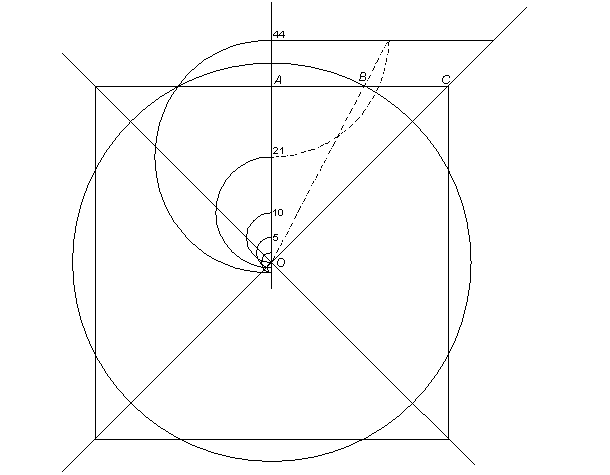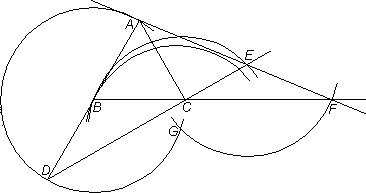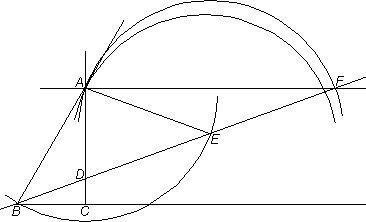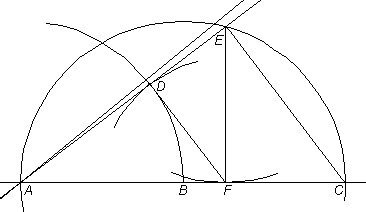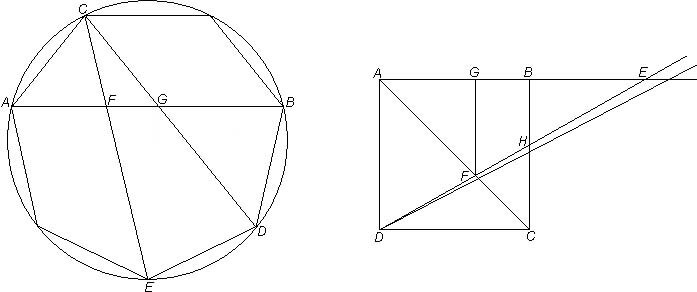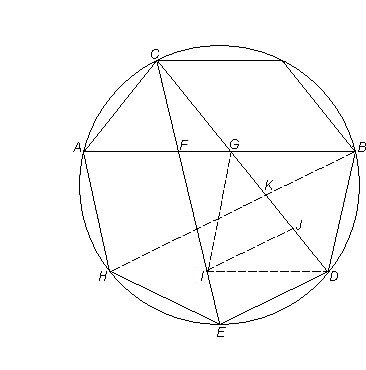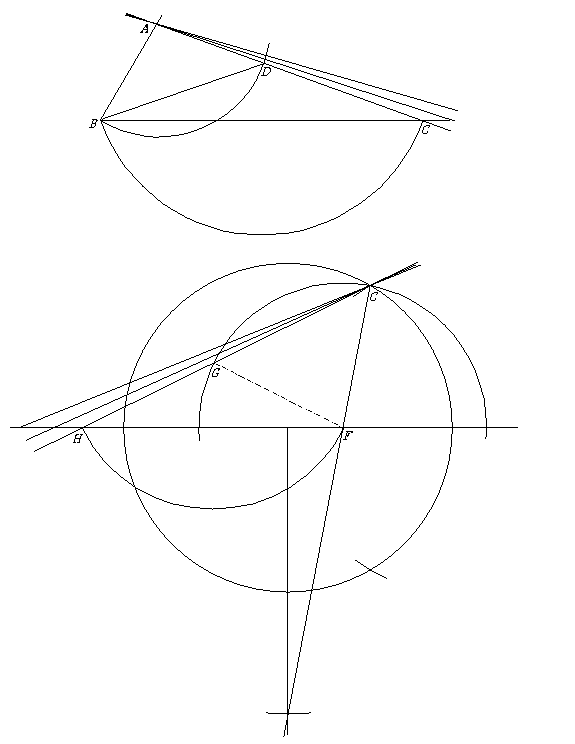
It is about a heptagon construction shown on page 265 of the book by Professor Hartshorne. In it the distance CF is marked on a ruler by which that distance is then transferred to segment GH by "sliding" the ruler so that the mark for G falls on arc CG and the mark for H falls on line HF while line HGC goes through C. What was not recognized is that the same is accomplished if a compass with a center G on arc GC is positioned to describe an arc from F to a point H lying on lines HF and HGC which goes through C. In this drawing an unmarked ruler pivots on C till H is on the horizontal. (To briefly describe what in the construction is done before, with the right-side intersection of the circle and its extended horizontal diameter as center, and the radius of the circle, an arc is marked on the circle at C and the point vertically below it; with the distance between these two points as radius, and the same center as of the circle, the bottom arc on the vertical is marked; from that point the line to C is drawn, and with its intersection F on the horizontal as center the arc CG is described.)
Similarly to the preceding, in the first drawing a ruler for line ADC pivots on A till from B, on arc BD with center A, an arc BC with center D is drawn so that C is also on horizontal BC. Unlike before and in other cases, there is no preexisting radius like DC that could be marked on a ruler, making this a simpler construction than for instance on page 262 of the above book.
How this construction trisects an angle, here ABC, how for that matter the other drawing leads to a heptagon, will presently be omitted, there being opportunity for these elsewhere. (It may be helpful though to note that in the trisection the angle DBC is a third of angle ABC, and for the heptagon its initial sides are to be found by, with center H and radius of the circle, marking arcs on it above and below the horizontal—the distance then between the intersections on the circle of either of them and of the horizontal makes a side of the heptagon, with the other sides easily following.) What I wish to include is the following response I received by e-mail from Professor Hartshorne.
From: Robin Hartshorne [mailto:[email protected]]
Sent: Friday, November 15, 2002 6:40 PM
To: [email protected]
Cc: [email protected]
Subject: constructions
Dear Mr. Vjecsner
Thank you for your letter about constructions. In spite of your protestations, I find nothing controversial in your letter. You have given a mathematically correct construction of the trisection and the heptagon neusis step. These constructions are not classical "ruler and compass constructions" as required in the classical problems, because they make use of the ruler and compass in ways not allowed by the traditional constructions. (See explanation on p. 21 of my book). I would say you have invented a new tool, that is simultaneous use of the ruler and compass in a sliding manner, and with this tool you have solved these problems.
I wonder if your tool is equivalent to the use of the marked ruler--that is can it solve all and only those problems that can be solved with marked ruler?
Sincerely yours,
Robin Hartshorne
The in this e-mail cited p.21, as I mentioned in my reply, allows that "at any time one may choose a point at random, or [a point] subject to conditions such as that it should lie on a given line or circle", which is what my use of "neusis" or "sliding" consists in. And as I indicated, previous attempts at making any of the constructions with only unmarked ruler and compass were unsuccessful regardless of whether those movements are allowed or not. I am reiterating this to bring to attention that the present solutions mean more than the various ones produced with the aid of additional devices.
If this sounds like boasting, I might lessen the effect by saying that an intention of mine is to bring my capacities to people's awareness, so they will give a listen to other things I offer, which I feel are of benefit. The preceding puzzles, again, are among many others I confronted, and are not included in the book of mine spoken of on the home page. This does not mean I do not like to carry the preceding explorations farther, and I have in fact done so and will try to describe them subsequently.
14 December 2002
Viewing the first above construction once more, I can add that the pivoting of the ruler, too, can be avoided here, as well as in the other cases. One can start by drawing arcs from B with a center D on arc BD, till a straight line ADC can be drawn with the ruler.
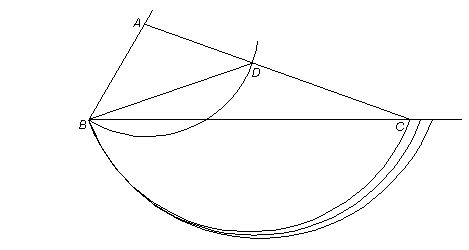
In light of such needed complication in even this trisection, probably the simplest compared to those known, which largely depend on the same proposition of Euclid, it may seem implausible if I offer a trisection simpler by far, whose rightness is so obvious that the impulse may be that the process is not legitimate. As to be seen, however, the process is none other than the "insertion" used on the many other constructions. What is more, the only tool for it in this case is a compass.
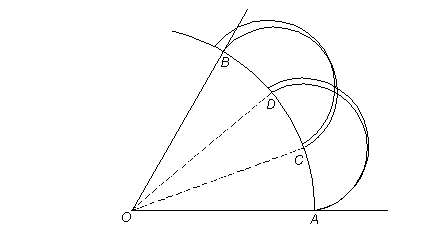
The job is made still easier than the previous ones by knowing that because thirds are concerned, of the reached difference from the goal of B can be taken an again estimated but much finer third by which the radius is rightly changed, since each small angle must change by that third to attain the correct three angles.
To almost end this session let me return to the heptagon. As was seen, the described construction of it, notwithstanding that the drawing left out parts unrelated to the present issue, is quite elaborate and had to avail itself of insertion regardless, with an added device to boot. Other past attempts, equally requiring insertion and additional tools, were similarly intricate. As the preceding drawing may suggest, however, a much simpler process is possible here, too, as the following drawing will illustrate.
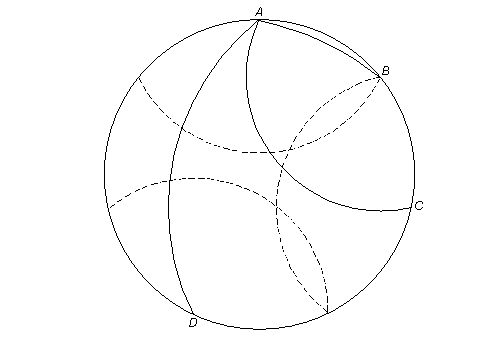
One could, to be sure, keep repeating the first arc, with each successive one centered at the endpoint of the former, till completion. But reducing instead the number of arcs not only shortens the job of "insertion", but the fewer the steps the smaller the chance of physical inaccuracy. The added dashed arcs in the drawing suggest a way to locate the remaining vertices.
It can be observed that the method in the last two examples can be employed to divide an angle into any number of equal parts, and to construct any regular polygon. The steps can, further, be drastically reduced by the likes of doubling each successive arc as in the preceding. Thus a 100-gon is constructible with 7 arcs.
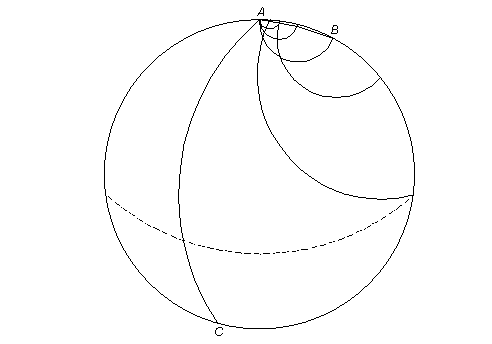
The viewer should not have too much trouble calculating that the length of the first radius is contained 100 times in the measure starting and ending at A. Counting from A, the first endpoint reached after B can be seen to be 14 times that radius, the next endpoint 27 times, C 54 times, and since B is from C less by 8, namely 46, so is on the opposite side A; and 46+54=100.
Where and to what extent arcs can in this manner be increased (which they needn't be) for a polygon, or for a divided angle, may not be always easy to detect, although there are normally several relations possible for such arcs. My objective was rather, again, to demonstrate that not only can these methods be economical, but that the process of "sliding" or "insertion" can often be performed with simplified structures and compass alone, let alone with an unmarked ruler besides.
It may be added that the above method of constructing any regular polygon or dividing an angle into any number of equal parts is more significant in geometry than it may seem. Geometers may be at a complete loss if asked to construct for example a regular polygon of some arbitrary number of sides. An aid like a protractor may be of assistance, if deficiently so, especially the larger the polygon. The same is the case when approximations for certain polygons exist. In contrast, the above method allows for more precision the larger the polygon, because the relative difference in accuracy can continually be reduced by any practicable amount.
26 December 2002
The next drawing utilizes once more the increasing arcs, this time without a need for "insertion", but the drawing is only an expected approximation in regard to "squaring the circle", one of the threesome of ancient problems mentioned. Its aim has been to construct a square of the same area as a circle, a task hindered by the irrational nature of connected pi, the measure of a circle's circumference in relation to the diameter.
In those constructions, pi, which is 3.14159... to infinity, has been approximated to half a dozen and more correct decimal places, and it is not the intention here to trump these, but rather to present a good approximation of exceptionally simple construction, by again only an unmarked ruler and compass. The approximation is to almost five decimal places, 3.14158..., which will be seen to go very far.
